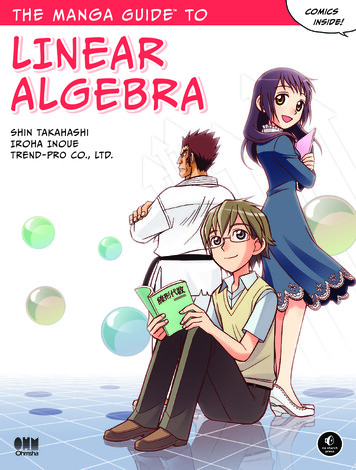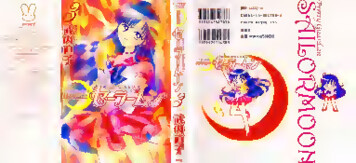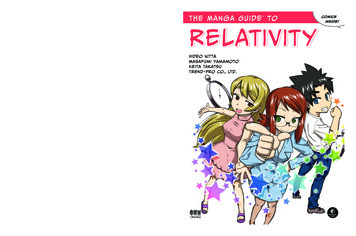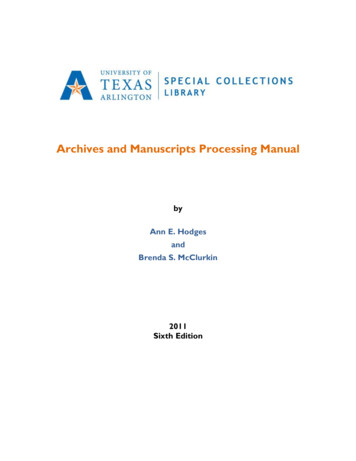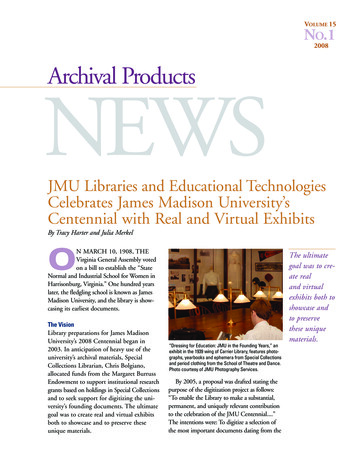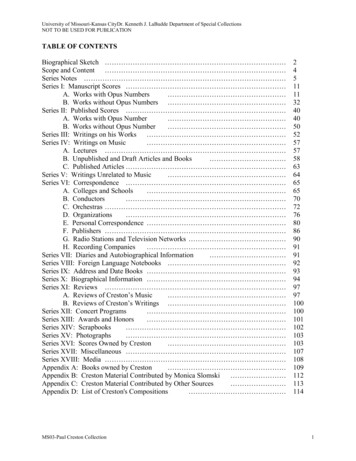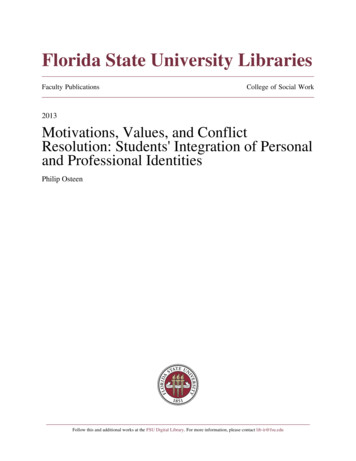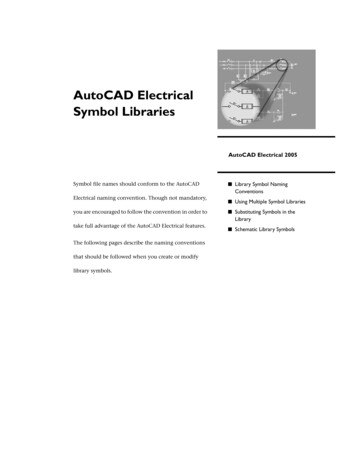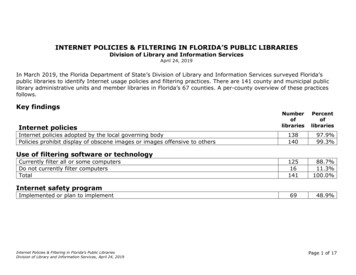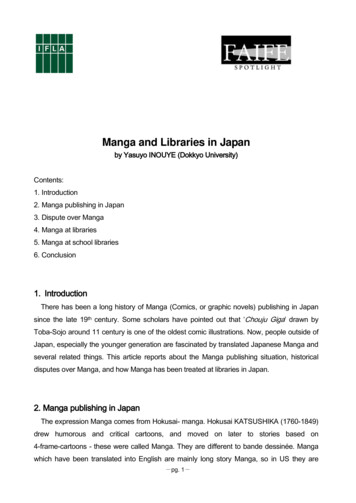
Transcription
Manga and Libraries in Japanby Yasuyo INOUYE (Dokkyo University)Contents:1. Introduction2. Manga publishing in Japan3. Dispute over Manga4. Manga at libraries5. Manga at school libraries6. Conclusion1. IntroductionThere has been a long history of Manga (Comics, or graphic novels) publishing in Japansince the late 19th century. Some scholars have pointed out that ‘Chouju Giga’ drawn byToba-Sojo around 11 century is one of the oldest comic illustrations. Now, people outside ofJapan, especially the younger generation are fascinated by translated Japanese Manga andseveral related things. This article reports about the Manga publishing situation, historicaldisputes over Manga, and how Manga has been treated at libraries in Japan.2. Manga publishing in JapanThe expression Manga comes from Hokusai- manga. Hokusai KATSUSHIKA (1760-1849)drew humorous and critical cartoons, and moved on later to stories based on4-frame-cartoons - these were called Manga. They are different to bande dessinée. Mangawhich have been translated into English are mainly long story Manga, so in US they are-pg. 1-
known as Manga ‘graphic novels’, but Manga includes not only fiction but also nonfiction likehistory, biographies and other reference materials. 4-frame-cartoons developed intoKamishibai which is a series of story cartoons on more than ten pieces of cardboard. Laterthose stories started to be printed in newspapers and magazines for children and youngpeople.Japanese Manga is still printed in magazines today, and also published in book format.Each magazine has a target readership, such as boys, girls, young men, young women,adults, and others. In the year 2010, there were 288 titles of magazines that printed mainlyManga. Among them 65 titles are for children and young people (28 for boys and 37 for girls)and 223 titles are for adults over 21-years-old (60 for young men, 61 for young women, 15classified as ‘boys-love’i, 22 print 4-frame-cartoons, and 65 for others)ii. Manga magazinesfor children and young people are aiming for both study and recreation. For example,“Weekly Shonen Jump” is a Manga magazine for boys. This magazine has been printed“ONE PIECE” by Eiichiro ODA and “DRAGON BALL” by Akira TORIYAMA serially, and wassold 2,876,000 issues in 2010. Most of Manga books are estimated by those magazineswhich age/sex readers are targeted. So “ONE PIECE” and “DRAGON BALL” are Manga forboys.Manga books based on those magazines for adults are often the main targets ofaccusations by the authorities. But a recent trend is Manga for girls which contains extremelysexually explicit illustrations and stories drawn by young women, and read by young girls.(Chart 1) Cumulative total printing numbers of Manga over one hundred millioniiiTitleNumber ofCreator (author)volumesDRAGON BALL1-42(all)Akira TORIYAMANARUTO1-54Masashi KISHIMOTOONE PIECE1-60*1Eiichiro ODASLAM DUNK1-30(all)Takehiko INOUEKochira Katsushika-ku Kameari Kōen Mae 1-172Osamu AKIMOTOHashutsujo *2 (こちら葛飾区亀有公園前派出所 )Doraemon: Gadget Cat from the Future1-45(all)Fujiko F FUJIOOishimbo1-105TestuKARIYAHANASAKIDetective Conan1-70-pg. 2-Gosho AOYAMA/Akira
Golgo 13*11-159Takao SAITOMost recent one is vol.64 which published on Nov.4, 2011, and printed over 4 million as firstprinting.*2 Not translated into other languages.Most of these Manga books are targeted at both boys and young men. Manga books forgirls and young women are not so widely sold like the books mentioned above, but severaltitles have been printed more than a million times. For example, “Glass Mask” by SuzueMIUCHI has been printed 355.82 million times (vol.1-46, continued), “Kimi nitodoke”( Reaching You) by Karuho SHIINA has 146.19 million (vol.1-12, continued),“Nodame Cantabile” by Tomoko NINOMIYA 35.6million (vol.1-25, finished), or “Clover” byToriko SHIINO 77.43 million (vol.1-23, continued) cumulatively.(Chart 2) publishing numbers of new Manga titles20062010New titlesGeneral%68,970(Manga)88.7(2,713)New titles68,142(3.9/3.5)4,8256.24,160Study al%74,714(4.3/4.3)5.63.2100.0(Chart 3) printing numbers of copies of 2392.0(Manga)Children(2,969)3,308Study 100.0-pg. 3-(9.8/9.0)91036,8755.52.5100.0
3. Dispute over MangaAs mentioned above, Manga was named after Hokusai Manga. Hokusai picked up thetheme of humorous illustrations about rich or high class people’s lives, or natural disaster andplague with irony or satire. After Japan changed from Samurai-centered society to modernindustrial society in the late 19th century, Manga has to criticized authority with humor. AlsoManga has been used to educate children and young people in learning natural sciences,machinery, geography, and moral education.The first Manga for children, ‘Shonen Kyouiku Nihon Ponchi E-hon banashi’ ( educationalcomic story for boys) was serially published from 1897 in a newspaper for elementary schoolstudents. Later, the first Manga book for children, ‘Shou-chan no Bouken’ ( adventure of aboy named Shou-chan) was published in 1923. This was a fantasy Manga story. Then“Bouya no Mitsurin Seihuku” ( Jungle conquered by a Boy) by Takashi HAGA in 1939 and“Kasei Tanken” ( Mars Exploration) by Taro ASAHI in 1940 were published.iv They were anadventure story with information on the jungle or Mars. The first Manga book aiming for studymight be “Benkyo Manga” ( Study Manga) by Reiji AKI who was a former school teacher ongeography, published as a monograph in 1950v. He had drawn this Manga in the ‘MainichiShougakusei Simbun’ ( Mainichi Newspaper for Elementary-School-children) before andafter the World War 2.In those days there were about 700 public libraries and membership libraries in Japan,and a few offered a youth service with fees. Those libraries permitted youth to read booksinside the library building that included educational Manga books. Children rushed to go tothose libraries and read books and Manga. Observing this, more publishers started to publishmore Manga books.From 1938 and during World War 2 the Department of Interior announced its intention tocontrol reading materials for children including 33 Manga booksvi. After that Manga creatorsand publishers decreased the number of Manga publications and changed the content to warfavor stories. The authorities tried to control information through creating and publishing byrestricting books and magazines for children and youth at the time of the war.After the World War 2, the American occupation authority (GHQ) censored the content ofpublishing including children’s books, picture books, school newspaper, kamishibai, andManga. During this occupation era (1945-1949), ‘Kashi-honya’ ( rental bookstore) werewidely settled, and children or working teenage youth used them to get ‘Akahon Manga’ ( redcolored book cover Manga book, because mostly book cover illustrations were used redcolor) by paying very cheap fee. Those Manga books were criticized for containing too many-pg. 4-
violent and sexually explicit expressions. A critical movement against those ‘Akahon-Manga’depicted Manga as low. Some parents’ groups collected Manga books including OsamuTEZUKA’s “Astro boy” and burned them on street.In 1950, the first ‘Youth Protection Act’vii in wide-area was promulgated in Okayama bythe local government as an ordinance and this is still active now. This act indicates bothrecommended ‘good’ books and ‘harmful’ books for children and youth under 18-years-oldincluding Manga. The aim of this ordinance is protection and nurturing children and youthunder 18-years-old. Local government decides which book is ‘harmful’ or not without opencriteria. Now all 47 local governments hold this kind of ‘Youth Protection Act’.After the settlement of those local acts publishers and bookstores have tried to self-restrictby putting stickers indicating Manga for suitable age since 1991.In the late 50’s ‘Geki-ga’( Dramatic Manga) started to publish. ‘Geki-ga’ illustrates realisticstories and illustrations with lots of violent battle scenes. Also nonsense comics with manysexually expressions were widely published. Then, in the late 70’s more ‘Story-Manga’( graphic novels) begun to be published as books based on Manga magazines. Schoolauthorities and parents, and others insisted those Manga contain lots of ‘harmful’ wordexpressions and illustrations for children. They demanded local government revise thecontent of the ‘Youth Protection Act’ and restrict the stream of free expressions on Manga.A more recent dispute over Manga and Anime was a revised proposal by the TokyoMetropolitan Government in 2010. The Tokyo Metropolitan Government tried to prohibit theviolent or sexually explicit expressions with ‘non-existent youth’. The Tokyo governor,Shintaro ISHIHARA, is also a professional writer who often mentions the Manga, Anime, andvideo games related to this bill. Not only the ‘Writers’ Guild of Japan’, publishers and Mangacreators’ groups but also the Japan Federation of BAR Association and Japan LibraryAssociation joined forces to protest against this revised proposal because it was seen toviolate freedom of expression. This proposal changed ‘non-existent youth’ to more concretesentences, and most policy makers at Tokyo Metropolitan Congress agreed with theproposal and passed it. 80% of publishers in Japan locate their headquarters at Tokyo, somany of them are influenced by this Tokyo ‘Youth Protection Act’.4. Manga at LibrariesNow what have librarians done with Manga at their libraries? In the late 19th century localgovernment instituted prefecture libraries and some offered materials and places for children-pg. 5-
and youth. School libraries started to operate before public libraries, even though the scalewas very small.After enacting and enforcing Library Lawviii in 1950 and School Library Law in 1953, morelibrary services for children and youth have been discussed. The first national meeting onchildren’s services was held and discussed on Manga at public libraries in 1955. About half ofschool libraries at both elementary and middle schools already offered ‘Gakushu Manga’( Study Manga) as a study aid. But children’s librarians at public libraries strongly hesitatedto hold Manga in their library collections and circulate them to children and youth. This wasdespite the Japan Library Associationix adopting ‘the Statement on Intellectual Freedom inLibraries’x in May 1954 with no exception of age.Librarians who were (are) protest against Manga at libraries insist that they express lots ofsexual, violent, segregated expressions, not suitable for young children, and that librariesshould not use their book budgets for Manga. Librarians who were (are) aware of theStatement on Intellectual Freedom in Libraries insist that libraries must provide books andother materials to everyone who want them including children, so Manga should be providedto those who want it. This discussion keeps going on now among librarians and others.Present librarians might select Manga from an educational standpoint. For example,Saitama prefecture library union catalog system (containing the catalogues of 58 publiclibraries) indicates that 44 libraries hold ‘Hadashi no Gen” ( Barefoot Gen) about World War2 and atomic bomb in Hiroshima but only 8 libraries hold “DRAGON BALL”. Alternatively,librarians may select from an academic standpoint or a literature standpoint. Even though 9libraries hold a Manga version of “ONE PIECE”, 22 libraries hold a novelized version of“ONE PIECE” without original Manga version.One alternative is for libraries to collect Manga books and other materials as part of aspecial collection. For example, one of the branches of Hiroshima city libraryxi holds onlyManga. Kyoto Seika University holds a Manga Museum inside the libraryxii because thisuniversity has a graduate school on Manga and offers doctor/master programs. MeijiUniversity are preparing a Manga libraryxiii with a collection donated by a graduate whobegun a comic-market in Japan. There are more research libraries at academiccircumstances.5. Manga at School librariesAs Manga in modern Japanese society started to be published with an educational aim,school libraries began to hold educational Manga. There are some standard collections of-pg. 6-
Manga books at school libraries. In 1962 Shuei-sha (manga publisher) started to publish“Manga Nihon noRekisi” ( Japanese History Manga version). Not only Japanese history but also Chinese orworld history Manga books have been published, and sold to school libraries mainly. Otherpublishers started to publish the same kind of educational Manga books.At elementary school libraries most Manga books are ‘Gakushu Manga’ ( Study Manga)but middle or high school level libraries hold more various story-Manga with educationalinformation. For example, “Hadashi no Gen”xiv, “Berusaiyu no Bara”xv , “Asaki Yume- misi”xvi,“Hikari to tomoni”xvii, “Donguri no iye”, “Oisinbo”xviii, “Kamui-den”xix, “Black Jack”xx,and so on.In the 1960’s elementary school teachers tried to use ‘Gakushu Manga’ ( Manga for study)as reading materials for substitute of textbooks, an innovation which included readingguidance. During the 1970’s and 1980’s, discussion over Manga among school teachers andschool librarians has become more heated, and criteria to select Manga at school librarieswas established.Criteria to review Manga for selection by School Library Association, 1988.xxi(1) Does it show the excellent quality illustrations?(2) Does it use vulgar words intentionally?(3) Does it respect the dignity of humanity?(4) Does it naturally go on and extend the story?(5) Does it try to stimulate readers’ minds by using vulgar expression?(6) Does its story praise an evil or injustice?(7) Does it glorify war or violence?(8) Does it treat the weak or disabled people in a discriminatory fashion?(9) Does it distort or ignore an academic truth or historical facts?(10) Does it treat real people correctly based on fair outlook and facts?(11) Does it suitable for intended readers?(12) Do they break the intention of the original works if they are?(13) Is its bookbinding and quality of paper strong enough for using by many readers?(14) Serial Manga which does not finish will be evaluated through all volumes after thestory ends fundamentally.Some school libraries which have established their own criteria to select Manga refer to theSLA’s criteria, and more school libraries collect Manga. Some public libraries follow the-pg. 7-
school libraries’ trend, and some accept whatever users demand.6. ConclusionLibrarians in Japan still are in favor to word-oriented materials. Also librarians know thatadult or teenage users can find Manga at different places like Manga-book-café,Manga-toshokan (membership Manga library), or second-hand bookstores. But how aboutyoung children? Does it enough for them to read only word-oriented materials? They havebeen born with multi-style information like moving images, Internet, and Manga. There wouldbe other effectiveness for young readers to read, study, and think.‘Boys-Love’ (BL) is named for the stories which is about gay love stories.『出版指標年報 2011』全国出版出版協会、2011. P222iii Above. P220.iv 清水勲『年表日本漫画史』臨川書店 2007 年 p144-145、150-151v �理 18(3)通巻 208 号 1964 年 6 月 p298-307vi �校図書館 No.358 1981 年 6 月 p9-15vii ‘Youth Protection Act’ , ‘Youth Protection Ordinance Reform Bill’ or so on. Each local governmentiiiuse different expressions, and the contents are partly different. Some mention only books, somemention sexual materials and magazines, and others mention to add video games. Mostly thoseacts try to protect children and youth under 18-years-old, but some set up them under16-years-old.法令データベース http://law.e-gov.go.jp/cgi-bin/idxsearch.cgiJapan Library Association x Statement on Intellectual Freedom in Libraries. tmlxi Hiroshima city Manga library ions/index.htmlxii Kyoto International Manga Museum p/french/xiii Tokyo International Manga Library http://www.meiji.ac.jp/manga/english/yonezawa lib/message/xiv “Hadashi no Gen” ( Barefoot Gen: a cartoon story about Hiroshima) by Keiji NAKAZAWA in 1973xv “Berusaiyu no Bara” ( Lady Oscar: La Rose de Versailles) by Ryoko IKEDA in 1972-73. The story isabout the life of Oscar who is a beauty in male attire for being a guard for Marie Antoinette at thetime of the French revolution.xvi “Asaki Yume- misi” ( the Tale of Genji) by Waki YAMATO in 1979-1983. The story is based on oneof famous classic story ‘The Tale of Genji’ which was written around AD1000 which is required readingmaterial at middle and high schools.xvii “Hikari to tomoni” ( with Light) by Keiko TOBE in 2001-. The story about the daily life ofsight-disabled people.xviii “Oisinbo” ( The Gourmet) by Tetsu KARIYA and Akira HANASAKI in 1983-2008. Cooking storyby a culinary journalist Shiro Yamaoka and Yuko Kurita who visit many restaurants or chefs.xix “Kamui-den” ( The legend of Kamui) by Sanpei SHIRATO in 1967.This is one Geki-ga manga, andthe theme is about segregated people at the time of Samurai to struggle to live.xx “Black Jack” by Osamu TEZUKA in 1975. The story about legendary doctor with a ‘God hand’ (butwho asks a high j-sla.or.jp/material/kijun/post-34.html-pg. 8-
Most of these Manga books are targeted at both boys and young men. Manga books for girls and young women are not so widely sold like the books mentioned above, but several titles have been printed more than a million times. For example, “Glass Mask” by Suzue MIUCHI has been printed 355.82 million times (vol.1-46, continued), “Kimi ni
